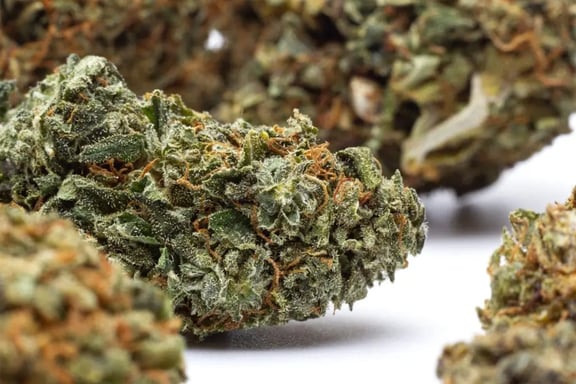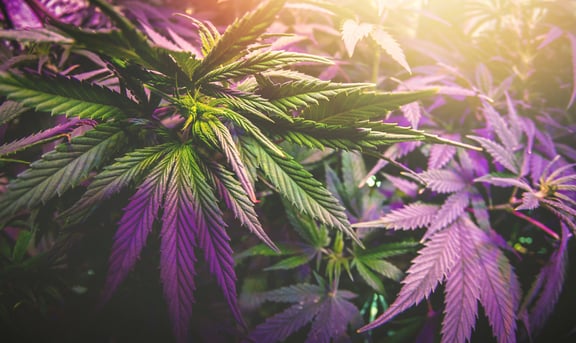Fibromyalgia is a mysterious condition that affects millions of people worldwide. It causes chronic pain, fatigue, cognition issues (commonly referred to as fibro-fog), and sleep problems, and all of this can take a real toll on a person's quality of life. It was only in 1987 that fibromyalgia was officially recognised as a medical condition, and while researchers have been working hard to understand it better, there is still no known cause or cure.
But this research hasn't all been in vain. As fibromyalgia becomes more understood and the rates of diagnosis increase, the need for non-conventional treatment options has also risen. One such treatment that has gained popularity in recent years is the use of medical marijuana.
But not all weed strains are created equally, especially when it comes to treating medical conditions. There are differences in the ratios of THC and CBD, terpene profiles, and other factors that can greatly impact effectiveness.
So, in this guide, we'll take a look at the best weed strains for fibromyalgia and how they can help alleviate symptoms and improve quality of life.
Key Takeaways
THC and CBD Benefits: THC can help with pain relief, relaxation, and sleep disturbances, while CBD offers pain management, anxiety reduction, and anti-inflammatory effects without the psychoactive 'high.'
Sativa, Indica, and Hybrid Strains: Sativas provide uplifting and energizing effects, Indicas are more relaxing and sedative, and Hybrids offer a balanced combination of both.
Consumption Methods: Different methods include inhalation, sublingual, topical, and oral, each with varying onset times and durations of relief.
Personalised Treatment: It's crucial to consult with a specialist experienced in cannabis and fibromyalgia to find the right strain and consumption method tailored to individual needs.
Potential Benefits: Medical cannabis can complement or offer an alternative to conventional treatments for managing fibromyalgia symptoms, but professional guidance is essential for optimal results.

What is Fibromyalgia?
At its core, fibromyalgia is a disorder that affects the central nervous system, causing widespread chronic musculoskeletal pain and tenderness. And as if that isn't enough, sufferers may experience fatigue, cognitive problems (difficulty with memory and concentration), headaches, irritable bowel syndrome, and sleep disturbances.
It affects more women than men, and many people with fibromyalgia also experience other chronic pain conditions such as arthritis or migraines. While there is no definitive cause for fibromyalgia, it is believed that a combination of genetic and environmental factors may contribute to its development.
How is Fibromyalgia usually treated?
Through a range of both pharma-based and holistic treatments, fibromyalgia can be managed. Pharmaceutical treatment options may include pain relievers, antidepressants, anti-seizure medications, or muscle relaxants. But these treatments can come with heavy side effects that some patients find simply intolerable.
Opioids can be quickly habit forming if not used with caution, and other treatment options may not provide long-term relief. For these reasons, many patients turn to complemntary/alternative treatments such as medical marijuana.
Understanding fibromyalgia and medical weed
So, at this point you are probably wondering how medical cannabis can help with such a complex condition?
The secret is in the cannabis plant's active compounds, specifically THC and CBD - both of which belong to a group of chemicals labelled cannabinoids. These cannabinoids interact with the body's endocannabinoid system (ECS).
What is the endocannabinoid system?
The ECS is the 'largest' neurochemical system in the body.
It is made up of 3 key components:
Endocannabinoids: These are the body's naturally produced cannabinoids. They work as the signalling molecules in the ECS, binding with receptors and regulating functions such as pain, mood, appetite, and sleep.
Receptors: These are found throughout the body and brain. CB1 receptors are primarily found in the brain and nervous system, while CB2 receptors are more abundant in immune cells. When endocannabinoids bind with these receptors, they can trigger a response in the body.
Enzymes: These are responsible for breaking down endocannabinoids and regulating their levels in the body.

How does medical marijuana help with Fibromyalgia?
The cannabinoids found in cannabis plants can interact with the body's ECS and potentially restore this balance. THC can bind with CB1 receptors, helping to alleviate pain and improve mood. Meanwhile, CBD has anti-inflammatory properties and can also interact with CB2 receptors, aiding in pain relief and reducing inflammation.
And then we have terpenes - the compounds responsible for the unique aroma and flavour of different strains - also play a role in cannabis' therapeutic effects. Some (but not all) terpenes have been shown to have anti-inflammatory, pain-relieving, and calming properties.
Although research on medical cannabis and fibromyalgia is still in its early stages, the results so far are highly promising. And there's an ever-growing body of anecdotical evidence that suggests cannabis can make a real difference to fibromyalgia sufferers' quality of life.
THC for Fibromyalgia
THC is the primary cannabis compound responsible for pain relief and increased relaxation. It can also help with sleep disturbances, anxiety (at the right dose), and fatigue.
Because of its psychoactive effects, some patients may want to start with lower THC strains and gradually increase their dosage as needed.
CBD for Fibromyalgia
CBD is a non-psychoactive cannabinoid, meaning it won't make the user feel 'high.' It has shown great potential in managing chronic pain, anxiety, sleep, and inflammation.
It also has minimal side effects and has been shown to be very well tolerated by patients.

Are Sativa, Indica, or Hybrid weed strains better for Fibromyalgia?
When it comes to choosing the right strain, it's not as simple as picking between Sativa vs Indica. Each individual strain has its unique combination of cannabinoids and terpenes that can impact its effects. We heavily recommend that patients looking to add cannabis to their fibromyalgia treatment plan reach out to a private medical cannabis clinic before trying out different strains.
That said, lets quickly go over the differences between Sativa, Indica and Hybrid strains to understand why they are each favoured by different users:
Sativa: Sativa strains tend to be more uplifting and energizing. They may also help with creativity and focus. For fibromyalgia patients, a high-CBD Sativa strain may offer pain relief without making them feel tired or mentally foggy.
Indica: Indica strains are at the other end of the spectrum, known for their relaxing and sedative effects. These strains can be helpful in managing pain, inflammation, and sleep disturbances.
Hybrid: Hybrid strains are a combination of Sativa and Indica genetics. The vast majority of medical strains sit in the hybrid category. These strains can be tailored to provide a more balanced effect, depending on the ratio of Sativa and Indica present.
The best weed strains for Fibromyalgia
Please keep in mind that the following strains are only a small sample of what's available to UK medical cannabis patients, and these recommendations should not replace a professional's advice. A specialist who has experience in both conventional and cannabis medicine, and also fibromyalgia treatment, is best placed to help you find the strains that are most suitable for you.
Here are a few of the potentially best weed strains for fibromyalgia for patients to consider:
How should you consume medical marijuana for Fibromyalgia?
The best consumption method varies from patient to patient, and it's something that patients should discuss with their specialist. That said, here are a few of the most common methods:
Inhalation: This is the inhalation of vapourised cannabis flower or oil using a vaporiser. Inhaling your medicine allows for fast onset and is a good method for managing acute symptoms such as pain or anxiety.
Sublingual: Sublingual administration refers to placing a few drops of cannabis oil under your tongue and holding it there for about 60 seconds, where it is then absorbed into the bloodstream. This method offers a fast onset and is good for managing pain, anxiety, or sleep disturbances.
Topical: Topical cannabis products include creams, lotions and balms that can be applied directly to the skin over affected areas. These may offer relief from localized pain and inflammation.
Oral: Oral administration involves consuming cannabis oils or capsules via the mouth. This method is slower to take effect but can provide longer-lasting relief from symptoms.
Final thoughts
Medical cannabis has shown great potential in managing fibromyalgia symptoms, offering an complementary (or even alternative) treatment option for patients who have not found success with conventional methods.
Before you try medical cannabis for fibromyalgia, we highly recommend seeking guidance from a specialist. Every patient is unique, and what works for one may not work for another, so it's crucial to find the right strain and method of consumption for your individual needs.
So, don't be afraid to ask questions and educate yourself on the available options - you may find that medical cannabis is the missing piece to your fibromyalgia treatment puzzle.












.jpg)